new posts in all blogs
Viewing: Blog Posts Tagged with: Feature articles, Most Recent at Top [Help]
Results 1 - 18 of 18
How to use this Page
You are viewing the most recent posts tagged with the words: Feature articles in the JacketFlap blog reader. What is a tag? Think of a tag as a keyword or category label. Tags can both help you find posts on JacketFlap.com as well as provide an easy way for you to "remember" and classify posts for later recall. Try adding a tag yourself by clicking "Add a tag" below a post's header. Scroll down through the list of Recent Posts in the left column and click on a post title that sounds interesting. You can view all posts from a specific blog by clicking the Blog name in the right column, or you can click a 'More Posts from this Blog' link in any individual post.
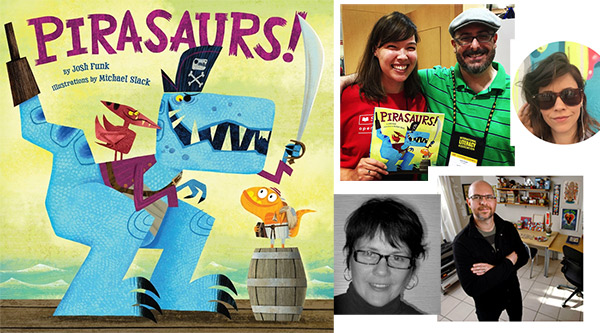
Back in May 2013, I posted an interview with Celia Lee, an editor at Cartwheel Books / Scholastic, and Celia invited Inkygirl readers to submit manuscripts for a limited time; apparently Celia received over a thousand submissions (!). A couple of years later, I met Josh Funk at nErDcampMI and found out that he had sold one of his picture book manuscripts to Celia as a result of my Inkygirl post, and it was being illustrated by Michael Slack.
I'm thrilled that PIRASAURS! is launching this week from Cartwheel/Scholastic. You can find out more about the book at the Scholastic page about the book, Josh Funk's Pirasaurs! page (where you can also find lesson ideas, reviews, links to other interviews and more), and the trailer below:
I asked Josh Funk how PIRASAURS! got created, and here's what he told me:
 On February 27th, 2013 at 2:53 in the morning, I woke up. I don't remember what I was dreaming of. I don't remember what I watched on TV the night before or what I ate for dinner (or late night snack). I do know that I sent a text with a single word to myself:
On February 27th, 2013 at 2:53 in the morning, I woke up. I don't remember what I was dreaming of. I don't remember what I watched on TV the night before or what I ate for dinner (or late night snack). I do know that I sent a text with a single word to myself:
pirasaurs
Ok, maybe that's not a word (yet). But it was a single string of letters. And I knew what to do with them.
Over the next two days, I furiously wrote a story featuring pirate-dinosaurs and a slew of other characters. It was my first time using internal rhyme (rhymes within a single line of text) and I had a blast with it. It turned out to be sort of a concept book. There were a bunch of crazy characters. The ending didn't really make all that much sense. But about 40 hours later, I had a full first draft that was ready to be sent to a critique group.
Here is the opening section of the 'Concept Book' version of Pira-Saurs!
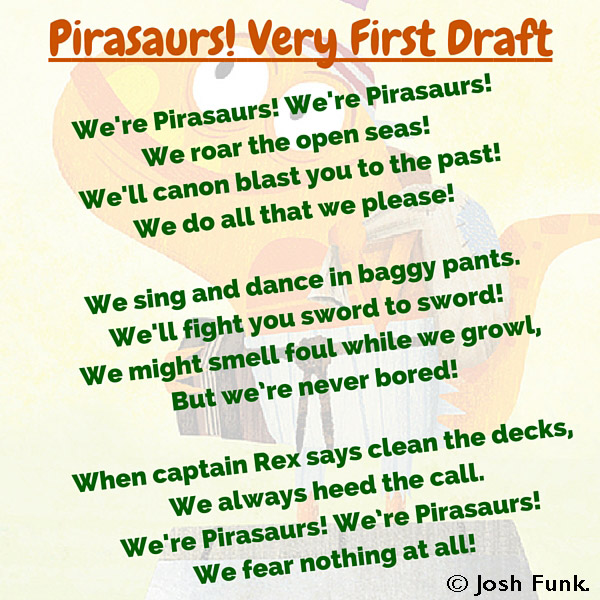
I brought the manuscript to my critique group twice over the next three months, and while much of the manuscript was tweaked, the opening Pira-Saurs! section stayed pretty much the same.
And then on May 20th, 2013, Debbie Ohi posted an interview with Celia Lee, editor at Cartwheel Books an imprint of Scholastic. Within a week, news had spread that a fancy Scholastic editor was accepting unsolicited submissions of picture books for ages 0-5. The funny thing was, Pira-Saurs! was the only manuscript I had that really fit the 0-5 age range. Most of the manuscripts I'd written fell more into the 5-8 area (although I personally believe that most of what I write is good for anyone between the ages of 0 and 92).
So, in late May, I sent Pira-Saurs! to the Scholastic offices in NYC via snail mail. I never sent Pira-Saurs! to anyone else. And then I went about my business, because at the time, I had no book deals, no agent, and really, I'd never received any positive feedback on anything I'd sent to an industry professional up to that point.
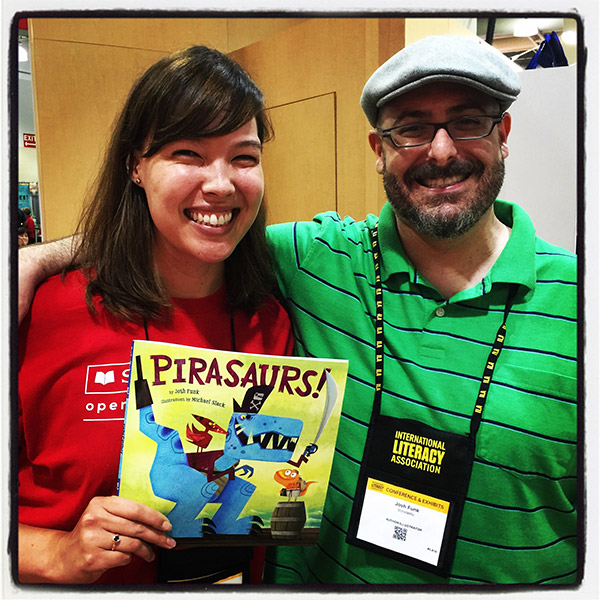 PIRASAURS! author Josh Funk with his editor, Celia Lee
PIRASAURS! author Josh Funk with his editor, Celia Lee
And then on July 9th, my phone buzzed. I'd received an email with the subject "Pira-Saurs! for Cartwheel Books" and everything slowed down. I was used to getting email rejections, so when I saw that it was a writing-related email, I instinctively thought, "oh, well, another no." But a few more synapses fired and I realized that I'd only sent Pira-Saurs! to one person, and it had been snail mail. And why would an editor bother sending an email rejection to a snail mail submission? That just wouldn't happen. Could this actually be good news?
Yes! Celia Lee had found the manuscript and liked it! It wasn't perfect (yet), but she wanted to work on it before bringing it to acquisitions. The next ten days were a flurry of emails and brainstorms and waking up in the middle of the night with new lines and rhymes. And on July 19th, Celia thought the manuscript was ready to bring to acquisitions. Hooray!
Or not hooray? On September 5th, Celia wrote back that Scholastic was going to pass on Pira-Saurs! ... but, they editorial team liked my voice and writing style. Celia asked if I would write another story, this time featuring just Pirasaurs - and cut the rest of the slew of other characters. My answer was "Of course!
But all I had were those three stanzas. And I needed to create a whole story with a full plot and compelling characters. And as an unpublished, unagented writer, I felt I needed to strike quickly before Celia Lee forgot who I was. I frantically wrote a draft, shared it with a few critique partners:

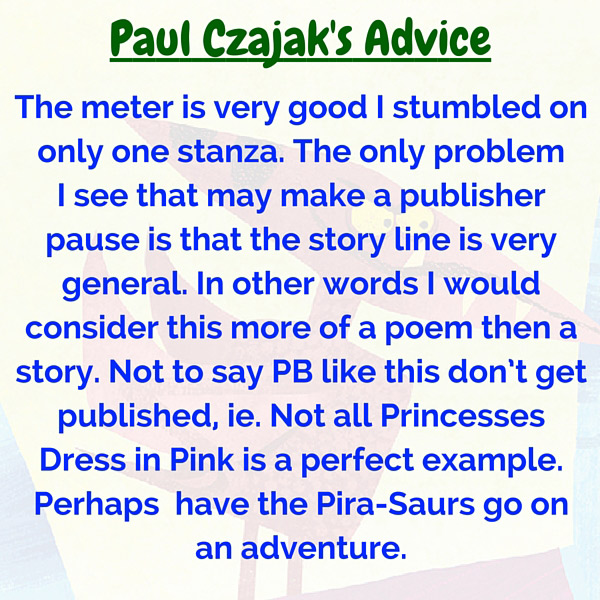
Thank you, Paul Czajak for suggesting I add an adventure and Anna Staniszewski for pushing that I add a little heart. Within a week of rejection, I had sent Celia a brand new completed manuscript. We revised it over the next few days, and on September 19th (which happens to be Talk Like a Pirate Day), I handed it off to Celia to take to acquisitions again. I didn't hear anything until a month and a half later, I received an offer on Lady Pancake & Sir French Toast and subsequently signed with an agent. At that point, Celia mentioned that the editorial director and art director were trying to set up a meeting to discuss potential illustrators before taking to acquisitions. I was told this was a good sign. And by late January of 2014, 8 months after Debbie's interview, Scholastic offered to acquire Pirasaurs! And pretty quickly they found the perfect illustrator... Michael Slack.
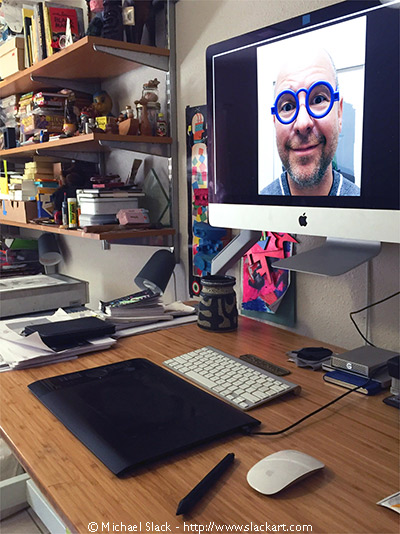 Illustrator Michael Slack's creative space.
Illustrator Michael Slack's creative space.
From Debbie:
Illustrator Michael Slack worked with art director Patti Ann Harris, editor Celia Lee and designer Jessica Tice-Gilbert for Pirasaurs!

Michael says that he did a lot of sketches early on. "Pages and pages of dinosaurs, hats, swords, and cannons."
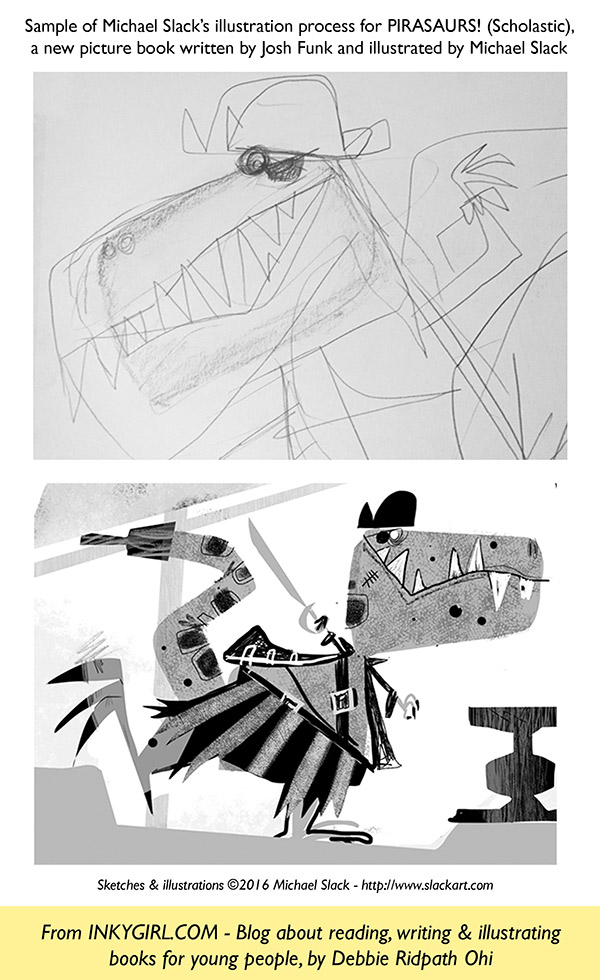
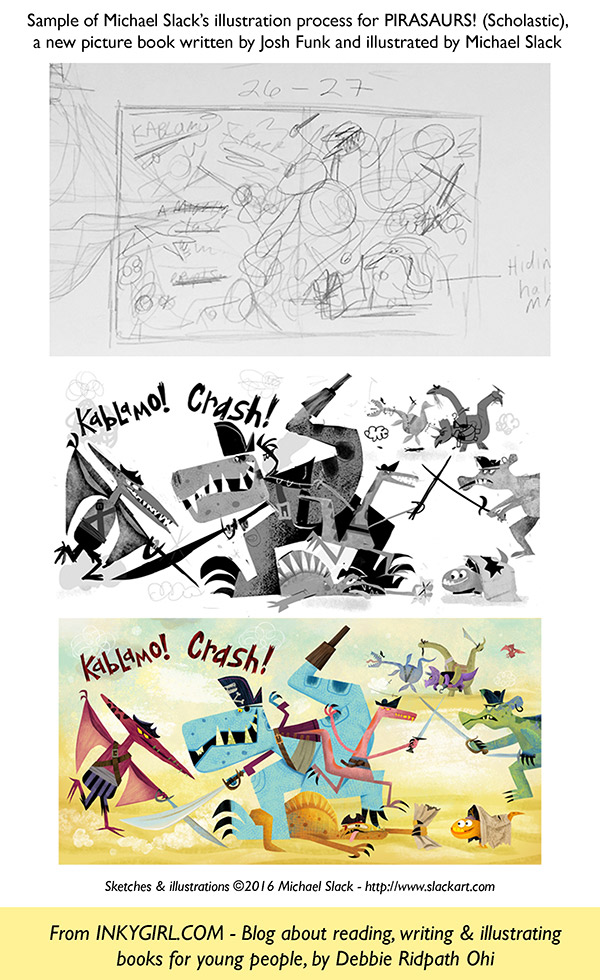
"Once I found the characters I did a few rounds of really loose thumbnails. After I had the story pacing in good shape, I switched from pencil and paper to digital to create the sketch dummy. Ultimately I ended up with three different versions of the dummy. The final illustrations were digitally painted in Photoshop."
Thanks to both Michael and Josh for sharing about the process of creating PIRASAURS!
You can find out more about PIRASAURS! at the Scholastic website.
More about Josh Funk and his work at JoshFunkBooks.com.
More about Michael Slack and his work at Slackart.com.
------
For more interviews, see my Inkygirl Interview Archive.
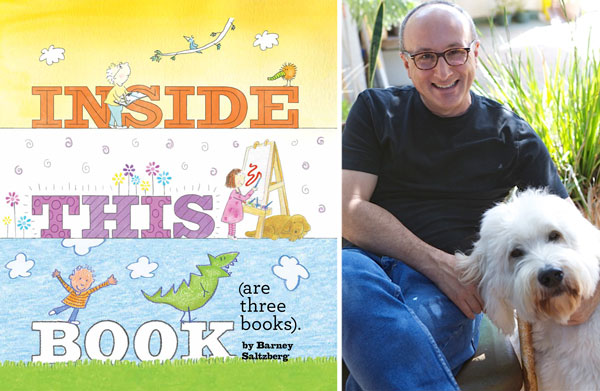
Barney Saltzberg is the author and illustrator of close to 50 books for children, including Beautiful Oops!, Arlo Needs Glasses, Andrew Drew and Drew, and the bestselling Touch and Feel Kisses series with over one million copies in print. Not only that, but he's also recorded four albums of music for young people (!). See the children's concert clip later in this post.
I was lucky enough to meet Barney at ALA earlier this year and more recently discovered his BEAUTIFUL OOPS!...I can't believe I missed this wonderful book before! Those of you who've seen my found object art demos can guess why I fell in love with this book. Do check out Barney's Celebrate Oops! campaign, an initiative designed to build confidence and turn accidents into teaching moments.
You can find out more about Barney and his work at his website, Twitter, Facebook, Instagram, Pinterest and YouTube.
Synopsis of INSIDE THIS BOOK (ARE THREE BOOKS) from Abrams:
"Inside This Book is a tribute to self-publishing in its most pure and endearing form. Three siblings create three books of their own using blank paper that they bind together (in descending sizes to match birth order). One sibling’s work inspires the next, and so on, with each book’s text and art mirroring the distinct interests and abilities of its creator. Upon completion of their works, the siblings put one book inside the other, creating a new book to be read and shared by all!"
Q. Could you please take a photo of something in your office and tell us the story behind it?

I photographed an electric pencil sharpener that my picture book writing teacher extraordinaire, Barbara Bottner gave me when I was working on my very first book which she mentored me through. It mean so much that she believe in me enough to work with me above and beyond, and for her to think enough of my work to give me a pencil sharpener to encourage my drawing. I couldn’t help but add the giant pencil to the photo. It is only fitting. This was a present from my wife and children many years ago. Talk about support and encouragement to dream big! Both of these are important mementos in my studio.
When I was in elementary school, my teachers often sent me home with notes; “Your son has potential, but we don’t know what to do with him.” I am sure that if I were in school now, I would be diagnosed with a number of learning issues. Luckily, I had a teacher, Mr. Maurer, in the fifth grade. He realized I couldn’t spell, (or multiply, or conjugate, etc;) but he recognized that I was a story teller. I wrote a book that was inspired by this years ago called, (Phoebe and the Spelling Bee) Every week, the day before our spelling test, Mr. Maurer would give me the spelling list and have me make up a story on the spot, in front of the class. I never practiced. I winged it every week. I loved the challenge. Looking back at my childhood, I realize that Mr. Mauer found a way to let me shine, in an otherwise, dismal time in an academic setting. He was a truly amazing teacher.
That’s a long winded introduction to my life as an author/illustrator. I find myself standing in front of thousands of students every year as I travel around the world. It never ceases to amaze me that I am being given an opportunity to address children. When I was in school, drilling a hole in the clock with my eyes as I willed it to be 3:00 so I could go home, I never imagined that I would return to so many schools as a published author. (And, love being there!) I always make a point of saying, “For those of you wondering, if you don’t give up, it gets better! I am the poster child for tenacity.” (Then I explain what tenacity means!)
Q. What advice do you have for young writers?
My advice for any writer is to be open. So many of us are certain we have the next ‘big thing’. My story has seventeen sequels. I see it as a movie. If things go right, there could even be a theme park modeled after this book. Dolls, toys, etc. SLOW DOWN. Editors are really smart. Listen to them. I have learned to ‘sleep on it’ for a night (at least) when an editor makes suggestions. This would also go for a critique group as well. Try on the suggestions and see how it feels. I also recommend reading your work out loud while you are proofing things. Also, have someone else read it out loud to you. You will have an opportunity to ‘hear’ your story in a way that is only possible when someone else reads it to you. Also, you know how to read your own stories and it is really helpful to see if the reader gets tripped up or lost or better yet, if they fall in love with your story. That will usually only happen after a million and six re-writes.
Q. What are you excited about right now?
My current book is one I published with Abrams, Appleseed Press called, Inside This Book (Are Three Books). I am a huge Emily Gravett fan and she opened my mind when it comes to the physicality of books. I had done many interactive books like Beautiful Oops and A Little Bit Of Oomph before, but I started adding flaps to some of my picture books as well. Chengdu Could Not, Would Not Fall Asleep, and Andrew Drew and Drew are all picture books with additional flaps. As a musician, I am really aware of the rhythm of a page turn so having the additional flaps in a picture book adds to the way a story unfolds. (Literally and figuratively) Inside This Book (Are Three Books) is a story about three siblings who are given three different sized blank books and how each child creates their own, individual book and what they do with them. Physically, it’s like Russian dolls, with books. I was delighted that Abrams was open to the concept of binding three sequentially smaller books inside of one book. My hope is that this book will help to inspire a whole crop of budding writers and illustrators.
------
For more interviews, see my Inkygirl Interview Archive.

The quandary: You want to support someone's new book and as much as you'd like to buy it, you can't. Perhaps you can't justify the cost of the new book right now. Perhaps your author friend is prolific and has multiple books coming out, and you can't afford to get them all. Perhaps you have so many author and illustrator friends that if you tried to buy all their books, you'd need to sell your car first. Or your house.
Here are some other ways you can show support for an author's book:
First, read the book. How do you read it without buying it? Borrow it from the library. For picture books, you could even read the book AT the bookstore.
Reserve a copy at the library. At least at some libraries, this helps show the library that at least one person is interested in that book. If popular enough, the library may order more copies.
Review/rate the book. Post a rating and/or review in sites like Goodreads, LibraryThing, Amazon, BN.com or your own blog. If you didn't like the book, don't lie. Nilofer Merchant suggests using a phrase like "this book is not for you if you are xxx" because even this kind of negative review may help others know the book IS for them. Take a few extra minutes to browse the other reviews of the book and then (if the feature's available) Like the reviews that you did like or found helpful.
When you read the book, read it where people can see it. Not sure about the rest of you, but I'm always surreptitiously checking out the covers of books that people read in public. This is where print books have the advantage of digital. Read the book on public transit, in the park, on the beach, at the airport, while waiting in line. You never know when people will decide to check out the book just because they saw you enjoying it.
Recommend the book to others through social media. Including the book cover (either scoop the cover image from the publisher/author/illustrator website or photograph the book cover in the library or bookstore) especially helps. Even just a short "Loved this book!" along with the cover will be appreciated. You can make it even more personal by adding a reason why you loved it. Take the time to tag the author or illustrator; tagging not only alerts the author/illustrator to the post but it also encourages people to click your tag link to find out more about the person.
Share and retweet the author's or illustrator's posts. Be judicious -- don't share/retweet everything, especially if you tend to share/retweet a lot on your feed. To authors and illustrators: make sure your post is PUBLIC if you want it shared. I can't tell you the number of times I've started to share someone's FB post but then discovered that it's a Friends-Only post; even if I shared it, the only people who see it would be our shared friends who already have it in their feed. If you're confused, read this FB support page about how to control who sees your posts.
Post a photo of the book in the wild. Especially around launch time, I find that social media sometimes gets inundated with images of just the book cover. Make your post more personal by taking a selfie of you holding the author's book, or another reader with the book -- photos with people in them always get more Like-love. Or take a photo in a fun setting, like adding a cup of tea beside a picture book about a tea party, for example. Or if you see the book in your local bookstore or library, take a photo and tag the author or illustrator. I can't speak for other author/illustrators, of course, but I always appreciate when someone does this.
If the author or illustrator is on YouTube, subscribe to their channel so you can more easily find out when they upload new trailers or videos.
Talk about the book. Don't underestimate the power of word-of-mouth. Recommend the book to friends, work colleagues, your local bookseller and librarian. When a friend of mine recommends a book they personally like and think I'd like, too, I pay MUCH more attention than when I see a generic "this new book just came out, you should get it!" post on social media.
And meanwhile...
Whether or not you can afford to buy my book(s), THANK YOU SO MUCH to everyone who has supported me and my work! I really appreciate it.
Do you have other suggestions about how to support book authors and illustrators? Please post below.
Related Resources:
How To Support An Author's New Book: 11 Ideas For You - by Chuck Sambuchino on Writer Unboxed
How To Support An Author - by Nilofer Merchant
5 Quick Ways To Support Your Favorite Author - by Dorothy Wiley
How To Support An Author Beyond Buying Their Book - by Erin in Pub Crawl
Last Tuesday, Clare wrote a wonderful slice of life post about what everyday learning in a classroom really looks like and feels like, aptly entitled: Learning is Managed Chaos. These lines resonated with… Continue reading →
Guest Post by Janice Gillgren
So many people lead such fascinating lives, and there are so many fascinating places on our earth. The feature writer seeks to show that fascination in such a way that readers will want to know about it too.
What is a 'feature article'?
The definitions are varied, and the differences can be confusing. A 'feature', like the word 'item', can mean a whole thing,
I've been gradually updating my FAQ, including answering questions I'm frequently asked about getting into the business of writing and illustrating children's books. Here's the most recent update:
Q. You've talked about having a writing and/or illustration mentor. Do you have any advice about how I can find my own mentor?
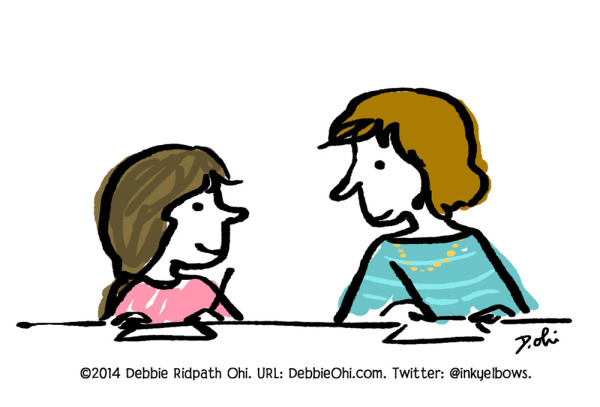
Background to my own mentorship experience:
One of my first writing mentors was Lee Wardlaw, a Santa Barbara children's book writer who was kind enough to read one of my first novel manuscripts and critique it for me. Then she worked with me on the manuscript and eventually recommended me to her agent at Curtis Brown, Ginger Knowlton. Ginger became my agent.
I will always be grateful to Lee, who agreed to read my mss after hearing about me from my father-in-law, a friend of hers.
In illustration, I entered the SCBWI Illustration Portfolio Showcase in 2010 in L.A. and won a Mentorship Program Award. That was a different type of mentorship: as part of the program, I receive 15 minute sessions with each of the six Mentors that year. I also received permission from some of the Mentors to send them occasional questions and updates after the convention.
There is no formal application for the SCBWI Illustration Mentorship Program -- everyone who enters the Illustration Portfolio Showcase at the annual SCBWI conference in LA is considered. Here is information about the 2012 SCBWI Illustration Mentorship Program.
CANSCAIP also has a Mentorship program for aspiring children's book writers and illustrators.
How to find your own mentor:
- Decide why you want a mentor. Are you looking for specific advice? Someone to recommend you to people in the industry who might help you? etc.
- Start by asking for one (possibly two) piece(s) of specific advice. That way you can see how the information is delivered, if it makes sense to you, whether your personalities are a good match, how receptive the person is to helping you. Avoid starting with a mega-long detailed e-mail that will require a lot of time and effort to answer.
- Choose a mentor you truly respect. When you approach them for advice, explain why you are asking them specifically. Flattery helps :-) but only if it's honestly given.
- I'd advise against saying you are looking for a mentor. That implies a ton of responsibility/commitment upfront and will probably make them uncomfortable. Understand that asking someone to be your mentor is like asking someone to go steady; DON'T ask unless you already have a good relationship with that person, because it puts them in an awkward position.
- Remember that it's okay to have more than one mentor.
- Don't waste their time. Don't ask them for advice that you could have easily looked up yourself online.
- Don't assume that everything your mentor suggests is right for you. You still have to think for yourself.
- If your mentor tends to always make you feel bad about yourself, get away from them!
- If someone's advice works for you, let them know. They will appreciate the thanks and will be more likely to want to help you in the future.
- Don't take it personally if someone doesn't have time to help you. Good mentors are often very busy.
A few suggestions about where to meet potential mentors:
- Small writing or illustrator groups that interact regularly in person or online.
- Local writers' or illustrators' organizations that meet regularly.
- Conferences, then keep in touch afterward.
- Writing classes.
When people ask me, "Will you be my mentor?"
I've had aspiring writers and illustrators ask if I'll be their mentor. In almost every case, the question comes from someone I have just met, or have never met. Some offer to pay.
My answer: With my own career just starting to take off (my first children's book was published in 2012) and multiple book deadlines coming up over the next few years, I lack the time to be a proper mentor. I also find that the older I get, the more curmudgeonly, and I get impatient with those who ask basic questions whose answers could be easily found online.
While I don't have time to be a formal mentor, however, I do what I can to encourage aspiring writers and illustrators, especially those whom I like. I also try to summarize things I've learned along my career path and post them online, like my Twitter Guide For Writers and Illustrators.
I no longer have one formal mentor. Instead, I learn from several, especially the people I work with. I also am learning so much from my writer and illustrator friends, and share what I can with them as well.
Don't stress if you can't find a mentor! Attend conferences and other events where you can meet others in the industry. Form meaningful relationships. Share your own experiences and what you've learned.
Related resources:
13 Tips On Finding A Mentor
44 Ways To Find A Mentor
How A Writing Mentor Can Help You - by Julie Rayl
How to Find (And Keep) A Mentor In 10 Not-So-Easy Steps
You can find the above entry in my FAQ entry: How do I find a writing or illustrator mentor?
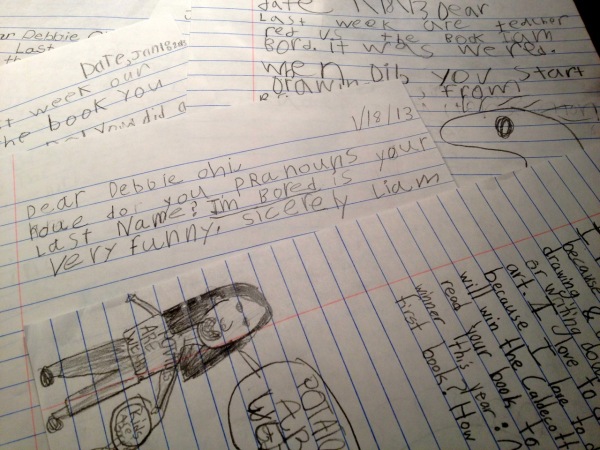
The whole I'M BORED adventure has been amazing and continues to be amazing. Whenever things start to settle, something else happens that reminds me all over again to appreciate every moment.
I was floored about how it all began, with a rejection and a friend's encouragement. Then came the Simon & Schuster BFYR book illustration contract and the SCBWI Illustrator Mentorship program. Then the fun and immense satisfaction in collaborating with my editor and art director on the project.
Because I had been so focused on just trying to get published in past years, I underestimated how much joy I would get from reader feedback. Wow.
Experienced authors and illustrators out there are likely much more used to this, but I'M BORED is my first children's book project and I'm still getting used to the fact that people out there -- people who aren't related to me and don't know me -- are looking at my illustrations in a published book they bought or borrowed.
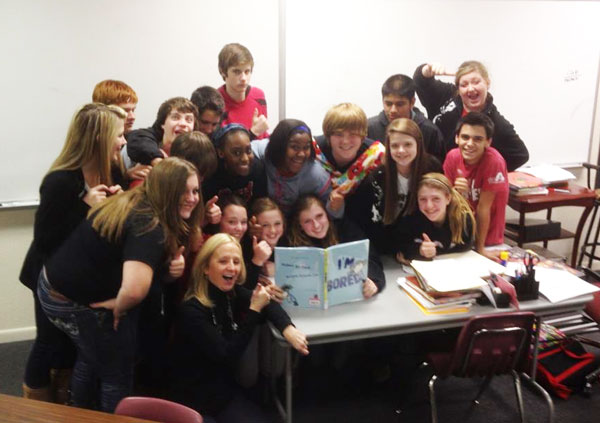
From Paula Speer White, who sent me the photo above: "This book is excellent for teaching verbal irony at the secondary level and self-efficacy at the elementary level~I give it a 10! Humorous, courageous, and witty!"
I've heard from some parents whose children have learning challenges or who are slow readers, who delight in the humor and want to read the book over and over again.
Parents tell me that their older children are enjoying the book as well, reading it on their own.
Librarians tell me that I'M BORED has become a favorite with their young readers. I so love the idea of a copy of the book eventually becoming battered and dog-eared because of constant use.
I think about a young person sitting down with a copy of I'M BORED, or perhaps having the book read to them by an adult, and try to imagine what happens as they listen to the story. Does it make them laugh out? Does it engage their imaginations? Do they identify more with the little girl or the Potato? Does the experience engage them enough to encourage a greater love of books and reading?
Does it change them for the better, even in a very tiny way?
Oh, I truly hope so.
What I've come to realize: While it's good to keep the market in mind (particularly if you want to get your work accepted by a traditional publishing house), remember that it's all about young readers. In the end, we create the magic for them, not the industry.
-----
For more fun photos, see the I'M BORED In The Wild reader gallery. If you'd like to submit a photo, here's how.
Teachers: if your class sends me snaimail about I'M BORED, I'll write back (with doodles!).
Back in May, I wrote a thank you letter to the Society Of Children's Book Writers & Illustrators. Stephen Mooser wrote back the following:
Hi Debbie—Wow and Congratulations—we keep a file, and a posting of SCBWI Success Stories and not only is yours one of the best, but it may also be the most entertaining of all time---you have made our day and we are so happy for your well deserved success—looking forward to seeing you again soon—all best wishes from all of us here at the office, Steve
As I was doing some prep for the SCBWI conference in LA next week, I realized that posting my thank you letter publicly might be of interest to some of you out there…especially those who have never been to an SCBWI event:
-------------------------
May 19, 2012
Dear SCBWI,
I’m writing to thank you all. Since I started attending your conventions regularly in 2009, so many opportunities have come my way.
I first heard about your organization and events from Santa Barbara area author named Lee Wardlaw, who was my writing mentor. Lee also introduced me to her agent at Curtis Brown, Ginger Knowlton, and Ginger eventually became my agent.
I was nervous when I decided to register for the Summer Conference in LA in 2009. I had attended many years before, but Lee had been there to introduce me around. This time I'd be going alone. What if no one talked to me?
When I got to the conference, I was surprised and delighted to find out that my fears were unfounded. Everyone was friendly, and I met kindred spirits everywhere: sitting beside me while we were waiting for a workshop or keynote to begin, at the many social events throughout the weekend, even in line for the women's restroom. Especially in line for the women's restroom.

And the BNA's were friendly and talked with me. Yes, even Jay Asher!
(You can see other comics I did leading up to the event here: http://bit.ly/xRxKRk )
I learned so much at that event and came away incredibly inspired plus during the year, I kept in touch with many of the people I had met.
Fast forward to the 2010 Summer Conference.
After I was rejected for the manuscript critique (it was my fault; I had misread the rules), my illustrator friend Beckett Gladney suggested that I enter the SCBWI Illustration Portfolio Showcase instead. I thought she was crazy because (1) I had no art training and (2) I had no portfolio. Beckett went through sketches and doodles I had been posting on Flickr, and helped me put together my very first portfolio.
AND THEN SOMETHING AMAZING HAPPENED.
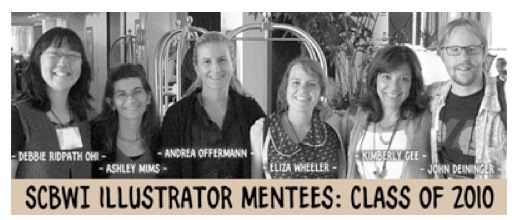
Not only did I win one of two runners-up in the overall Showcase, but I was also chosen for the SCBWI Illustration Mentorship Program. In addition to one-on-one sessions with six industry experts during the convention, I also met a wonderful group of illustrators who have since become friends.
We encourage and commiserate by e-mail, launched a SCBWI M
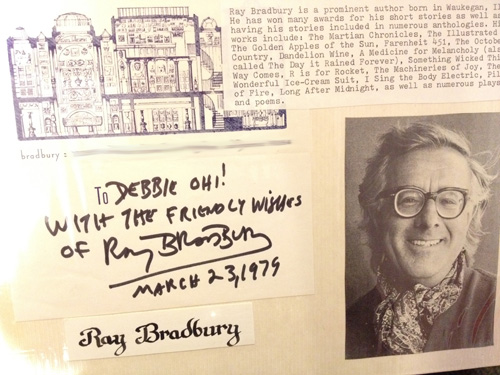
Above: page from my childhood autograph collection.
Just found out that Ray Bradbury died this morning at the age of 91. :-(
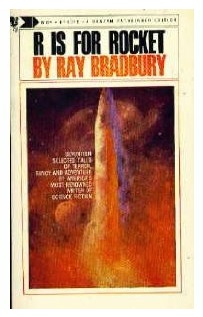
I always loved reading, but it wasn't until I read Ray Bradbury's Dandelion Wine that I became aware of style in writing. I'm generally a fast reader, but with Ray Bradbury's books I slowed way down so I could savour the language. His books helped me appreciate the importance of word choice, and also got me hooked on science fiction.
I wrote a song called "Homecoming" that was based on one of my favourite Ray Bradbury short stories, "The Rocket Man" (included in his R Is For Rocket short story collection). You can hear my group, Urban Tapestry, performing Homecoming in our live performance CD. I'm playing the rhythm guitar part on this track, Allison Durno plays lead guitar bits and Jodi Krangle sings lead. Allison and I sing some backup during the chorus. I've included the lyrics/chords below.
Even before I experienced family loss myself, I was deeply moved by this story and others by Bradbury. His writing affected me in so many ways, and was a major factor in my own desire to be a writer. I owe this man so much and had hoped to meet him in person someday.
For more info about Ray Bradbury, see http://www.raybradbury.com/
HOMECOMING
Words & music by Debbie Ridpath Ohi
Performed by Urban Tapestry (included on our live performance CD, Sushi and High Tea)
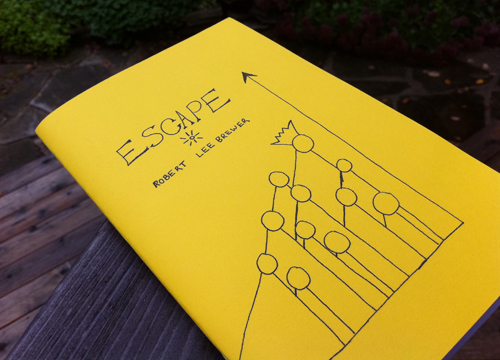
I used to hate poetry. I blame scholarly literary dissection and school. My memory (which, I admit, may be tainted by early years of accumulated hatred) is one of many hours of tortuous analysis, taking a few simple lines of text that I kind of thought were cool at first but then learned to dread as we hacked and slashed at every syllable, every nuance, every possible interpretation, until there was nothing left except a dry husk that made me want to run from the room screaming "ENOUGH WITH THE RED WHEELBARROW!"
Years later, a poet/librarian friend of mine introduced me to some poems that I actually enjoyed. That I LOVED.
Some poems, I discovered, could be understood and appreciated by the average person. I also learned to love the language of poetry, and became more aware of writing style and the importance of word choice in my own writing. Every word counts, after all, and not just in poetry.
Recently, I purchased Robert Lee Brewer's most recent poetry chapbook: Escape. I bought his first collection, ENTER, because I wanted to support Robert. He's been a wonderful editor at Writersmarket.com and great to work with, plus I've enjoyed his Poetic Asides blog. But the bonus: I loved Robert's poetry.
So when I found out that he had a new collection of poems, I ordered one right away. I have no formal poetry scholarly training and have never reviewed poetry before. All I can say, though, is that I LOVED THESE POEMS. They're full of emotion and music, and a joy to read.
If you're interested in owning a copy of Escape, send Robert Brewer an e-mail at robertleebrewer[at]gmail[dot]com, with "I Need an Escape" in the subject line. Price: $10 (which includes shipping to anywhere in the world). Do it before they sell out!
p.s. I actually do like The Red Wheelbarrow now.

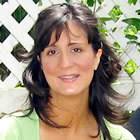 Tara Lazar is a children’s book author, mother, foodie and founder of Picture Book Idea Month (a.k.a. "PiBoIdMo"). Her first picture book, The Monstore, will be published by Aladdin/Simon & Schuster in 2013. Tara is represented by Ammi-Joan Paquette of the Erin Murphy Literary Agency. Find out more about Tara at her blog: http://taralazar.wordpress.com/
Tara Lazar is a children’s book author, mother, foodie and founder of Picture Book Idea Month (a.k.a. "PiBoIdMo"). Her first picture book, The Monstore, will be published by Aladdin/Simon & Schuster in 2013. Tara is represented by Ammi-Joan Paquette of the Erin Murphy Literary Agency. Find out more about Tara at her blog: http://taralazar.wordpress.com/
And stay tuned for PiBoIdMo 2011 this November!
What inspired you to start PiBoIdMo?
I got active in the online kidlit community in November of 2007. I learned about NaNoWriMo immediately--EVERYONE was chatting about it. I was jealous of novel writers having all the fun, so the following November I decided I would do something to inspire me as a picture book writer. I'd created one new picture book concept a day. I didn't make it through the whole month, though. I finished with 22 ideas, but one of them was for THE MONSTORE, my upcoming book with Aladdin/Simon & Schuster.
How many years have you run PiBoIdMo?
PiBoIdMo 2008 wasn't official, it was just me and a few local writing friends. I ran PiBoIdMo on my blog for the first time in November 2009. This past November was the 2nd year for the blog-based event.
How successful has it been?
The first year I ran PiBoIdMo, I didn't have a sign-up period, so I don't know how many people participated, but a little over 100 signed the pledge at the end, confirming they had at least 30 ideas. My website received 15,000 hits during November 2009, which, at the time, was the most active month the site ever had.
For PiBoIdmO 2010, there was a sign-up period which logged 404 particpants, with 201 completing the challenge. Web hits soared to 30,000 for the month and my blog was ranked in the top 100 book blogs by Technorati, making it as high as #10. I was blown away by the enthusiasm of the participators! Many blogged their daily progress. Megan K. Bickel, for instance, put her own spin on PiBoIdMo by creating ideas in alphabetical order.
And PiBoIdMo has netted others contracts and awards. Corey Rosen Schwartz came up with the idea for GOLDI ROCKS AND THE THREE BEARS during PiBoIdMo 2009, which was bought by Putnam in 2010. Diana Murray wrote a manuscript from a PiBoIdMo idea which won the SCBWI Barbara Karlin Grant. Those are the two PiBoIdMo success stories I know of, and I'm sure there's more to come! I hope people will contact me with their good news.
Have you enjoyed running it?
It's been a blast running it, but also a lot of work. The first year, I decided to do a daily post after I had already recruited guest bloggers. There were 15 guest bloggers, which meant I had to write 15 posts on my own. That was a bit much, so in 2010 I decided to schedule more guest bloggers. The response was surprising--there were more volunteers than days in November! So some of the guest spots rolled into early December. I had so much fun putting the posts together; I felt privileged to read all the great advice before anyone else.
Next year I might need a PiBoIdMo assistant! So many people volunteered prizes that I'm still doling them out in
As some of you may already know, some of my sites were hacked on the weekend. If you notice some missing images and features from this site, that’s why — I still haven’t finished the finetuning after major damage control had been done.
Many thanks to those who e-mailed, tweeted and sent me Facebook messages about the problem, and to Cid of Cidwrites.com and others for their advice. Biggest thanks to my technonerdboy hubby, Jeff Ridpath, who spent pretty much the whole weekend helping me get things back to normal.

For anyone else out there who uses Wordpress as their blogging platform, be aware that what happened to me could very easily happen to you. You might think you don’t have to worry because you just have a small site or figure that you don’t have any valuable info on your site anyway but trust me…it’s worth taking a few precautions to avoid going through the hassle of having to scrub your site clean and have to reinstall everything.

And if you get flagged by Google as a malware site, then you have the added embarrassment of the warning that comes up whenever someone tries to access your site. Even after you scrub your site, then you have to fill out an application to get Google to review your site.
Here are some things I learned from the experience that you may find useful:
- Make sure your passwords are strong. Read Protect Your Blog With A Solid Password. Don’t use any words that can be found in the dictionary. Other BAD passwords: names spelled backwards, phone numbers, birthdays, qwerty, asdf, yourname1, default, letmein, password1, your car license, middle names. Don’t use the same password for multiple sites.
- Keep your versions of Wordpress updated. As Alex King says, “Upgrade immediately. Always. No exceptions.”
- Keep your versions of plugins updated. Remove any plugins you aren’t using. Some older versions of plugins have security holes that hackers can use.
- Take regular backups of your file directories as well as your database. One security tips post I found recommended WordPress Database Backup.
- Be wary of letting an application have write access to your files. Keep your file permissions as restrictive as possible.
- Limit your use of plugins. I try to do this anyway, because I was finding that having too many plugins really slowed down page loading on my site.
- Turn off any features you don’t use.
And yes, I’m on the lookout for another blogging platform. If anyone has any suggestions, feel free to post below! I’m looking for a solid, secure blogging platform that is free or has a reasonable annual fee that includes multiple blogs.
Anyway, here are some useful resources I found while researching Wordpress and security issues:
Wordpress Security Tips and Hacks
20+ Powerful Security Plugins and Some Tips & Tricks
12 Comments on Inkygirl is BACK…and some security tips for other bloggers, last added: 6/1/2010

 On February 27th, 2013 at 2:53 in the morning, I woke up. I don't remember what I was dreaming of. I don't remember what I watched on TV the night before or what I ate for dinner (or late night snack). I do know that I sent a text with a single word to myself:
On February 27th, 2013 at 2:53 in the morning, I woke up. I don't remember what I was dreaming of. I don't remember what I watched on TV the night before or what I ate for dinner (or late night snack). I do know that I sent a text with a single word to myself:
 PIRASAURS! author Josh Funk with his editor, Celia Lee
PIRASAURS! author Josh Funk with his editor, Celia Lee

 Illustrator Michael Slack's creative space.
Illustrator Michael Slack's creative space.























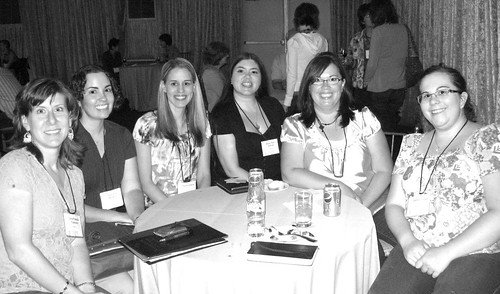
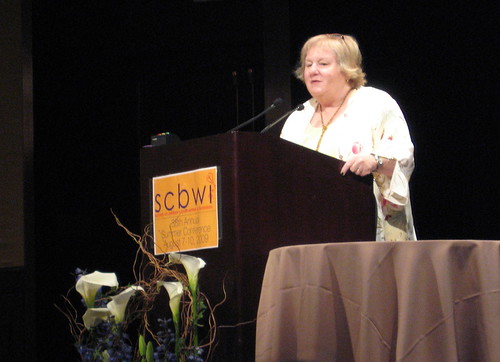

Yay for fixing the site and coming back! I’ve never used Wordpress. I use Blogger, which I really like. It’s very easy to use.
Wow, I am so terribly sorry you went through this. You seem to be positive and upbeat given the circumstances. It’s very generous of you to share this helpful information. May we link it and include it in our Friday blog round-up? This is going to help many people avoid disaster! The site is looking great and we’re rooting for you
Marissa
Brittany: Thanks!
AICP: I’d be honoured if you linked to it, thanks!
Another vote for Blogger here. Love Blogger.
So sorry that happened to you, but thanks for sharing what you learned with us!
Yay you’re back!
Thanks for the help! I use wordpress for damn near everything.
Mark
I’m so sorry you were hacked! I’ve been thinking about starting a Wordpress site, but now I’m going to have to seriously reconsider. Thanks so much for the tips, they’re very helpful.
I know how you’re feeling! My site was hacked once, too, and it was a pain to clean up. I still use WordPress… It’s not their fault I wasn’t keeping my installs updated. But correcting that and using the Secure WordPress plugin (found here: http://wordpress.org/extend/plugins/secure-wordpress/) resolved all my issues and I’ve had no problems since. I just thought I’d mention it, in case you’d like to try that instead of going to the time/investment/expense of moving platforms.
You can set up WordPress on Dreamhost to automatically upgrade when a new version comes out. It sends you mail to let you know it’s happened.
I’m looking for a good blogging platform that is based on Ruby on Rails, myself. Typo looked good, maybe I should try that.
http://wiki.github.com/fdv/typo
Thank you for these tips! My email was hacked a few months ago, so I know how frustrating (annoying! upsetting!) it is.
So glad you got this all fixed and are up and running again.
It’s a real pain to get hacked–been there done that. Business contact list was hacked. Hackers sent the entire list an email saying I was stranded in London without my cell phone and no money. Asked the whole list to wire money. The dummies even sent one to me at my other address! I straightened it all out but what a headache. No one sent money because the saw me the night before at a banquet and because of my elderly dad I was never separated from my cell.
That’s a bummer. In general, I think all platforms have security flaw potential, so I’m not sure that switching will help much. Or rather, it’ll help until it doesn’t.
Here’s another link to a helpful (to me, anyway!) article on wordpress blog security:
http://www.problogger.net/archives/2010/03/11/blog-security-girl-with-dragon-tattoo-movie/
Glad you’re back up!
Greg
Hey.
Do you think this is a problem with Wordpress particularly? Do you blog through Wordpress.com, or -.org?
Thanks for the advice, it’s not something I’ve really thought about, but certainly will now.
S